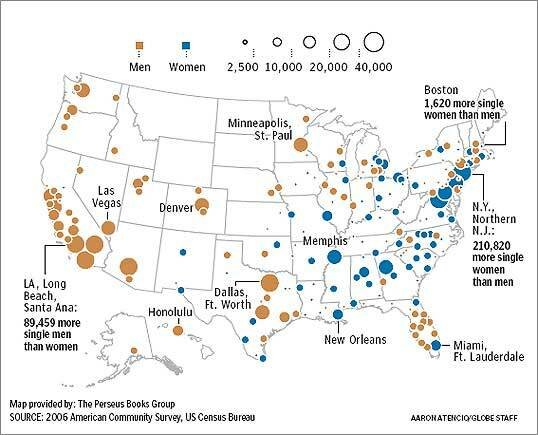Which cities have a surplus of single men (or women) – and what that means for the country
By Richard Florida | March 30, 2008
 WHICH OF THESE two decisions do you think has a bigger impact on someone’s life: finding the right job, or finding the right significant other? No one’s going to argue with the notion that where you live affects your employment prospects. But the place you call home has a lot to do with your chances of finding the right partner as well. Having an enticing “mating market” matters as much or more than a vibrant labor market.
WHICH OF THESE two decisions do you think has a bigger impact on someone’s life: finding the right job, or finding the right significant other? No one’s going to argue with the notion that where you live affects your employment prospects. But the place you call home has a lot to do with your chances of finding the right partner as well. Having an enticing “mating market” matters as much or more than a vibrant labor market.
It’s not just that some places have more singles than others. If you’re a single man or a single woman the odds of meeting that special someone vary dramatically across the country.
By far, the best places for single men are the large cities and metro areas of the East Coast and Midwest. The extreme is greater New York, where single women outnumber single men by more than 210,000. In the Philadelphia area and greater Washington, D.C., single women outnumber single men by 50,000. I met my wife outside Detroit, where the odds were greatly stacked in my favor – single women outnumber single men by some 20,000 there.
In fact, single women outnumber single men in many large cities around the world, even though men outearn women at all ages, according to Lena C. Edlund, a Columbia University economist. One reason young women in the prime marriage years – the 25-44 age range – flock to big cities is to compete for the most eligible men. And smart women who gravitate to vibrant cities are more likely to stay single – for longer, at least – because they rightly refuse to settle for someone who can’t keep up with them intellectually or otherwise.
But women do have an advantage in the American West and Southwest. In greater Los Angeles, for example, there are 90,000 more single men than women. In Phoenix and the San Francisco Bay Area, single men outnumber single women by roughly 65,000. There are considerably more single men than women in San Diego, Dallas, and Seattle, too. Each of these regions has grown substantially over the past two or three decades, offering jobs in everything from high tech to construction and services. As numerous studies of migration show, men – especially those in regions with declining economies – are initially more likely to move long distances for economic opportunity, while women are more likely to stay closer to home and family.
Being in a place where the gender odds are stacked against you can be very frustrating. “When I was in Chicago, it was never long between dates” says one single male. “When I’m hanging out with friends [in the San Francisco Bay Area], often times in a large room with few if any women, we routinely turn to the topic of how the dating scene sucks.”
Greater Boston is unusual among large metro areas. It is one of the very few with a near perfect balance of singles – having just 1,600 or so more women than men – 604,960 men to 606,580 women. And this may be part of the reason why the region ranks third for young singles on a ranking of more than 150 metro regions my team and I compiled. The entire region surrounding Boston and its immediate suburbs does well, too. Worcester; Portland, Maine; and Portsmouth-Manchester, N.H., also score among the top five for singles among small-medium-sized regions nationwide.
This high ranking is good news, because singles attract other singles. Numerous studies have found that young people pick where they want to live first and then search for a job in those places. When Forbes magazine asked young singles of both genders what matters most in the places they live, more said “number of other singles” than said “great career prospects”; things like “wild nightlife” and “low cost of living” came in much farther behind.
The ability to attract young singles also bodes well for regional economies. Singles are a large and growing segment of the population and the workforce. With many postponing marriage until their late 20s and 30s, and with a significant share of marriages ending in divorce, singles now make up more than half of all American households, compared with just 20 percent or so in the 1960s and 1970s.
In our highly mobile society – where 40 million Americans move every year and 15 million of us make significant moves to a new county, a different state, or a different country – younger singles are the most mobile group of all. People in their 20s are twice as likely to move as 30-to-34 and 3.5 times more likely than 45-54.
The end result of these millions upon millions of location decisions is likely to be a widening economic and cultural divide between the relatively small number of fortunate regions that attract singles who can choose where they want to live, and the larger number whose populations are older, less-skilled, more rooted, or even stuck.
Richard Florida is the author of the new book, “Who’s Your City?,” and director of the Martin Prosperity Institute at the University of Toronto’s Rotman School of Management.